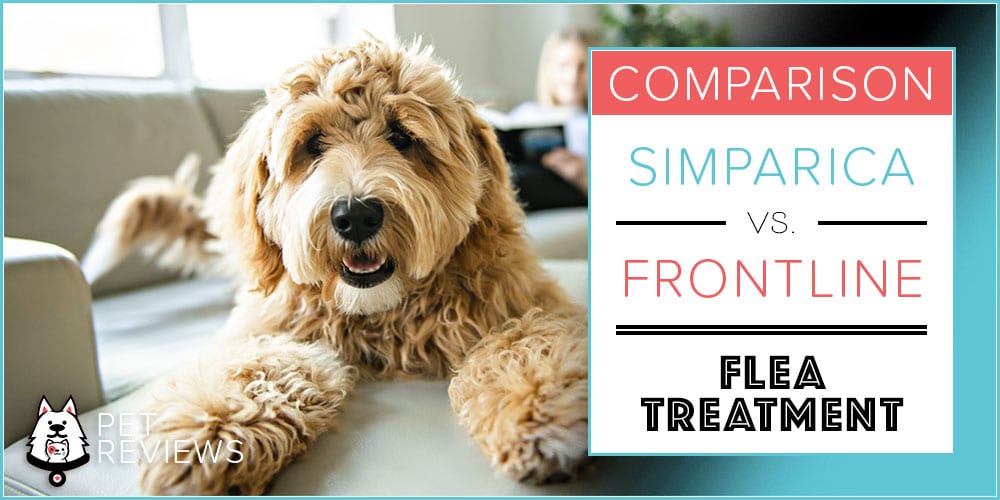Simparica vs. Frontline: 2024 Comparison and Key Differences
Quick Guide
We all want to keep our dogs as healthy as possible. Part of being a good pet owner is ensuring that they are protected from a common, though potentially dangerous, pest: the flea. When buying a flea treatment, you will need to consider how long the treatment lasts, how to administer it, the ingredients used, how your pup reacts to it, and even the cost.
The pet health market is flooded with flea treatment products. From oral chews to topical treatments to flea collars, this variety is both a positive and a negative. On one hand, with such a vast mixture of products, you are sure to find an effective one for your pet. On the other hand, too many options can be overwhelming, making your search feel never-ending.
Choosing a flea treatment for your pet can be a daunting experience. With so many products available, selecting the one that works best for your pet and for you can seem almost impossible. That’s why it is crucial to do some research before beginning your search. Keep reading for a comparison of two popular options: Simparica and Frontline.
What to Look For in a Good Flea Treatment?
Since there are a number of flea treatments offered, finding one that suits your dog will be simple once you consider a few questions. The first aspect to think about when it comes to flea treatment is how long it lasts. Depending on the product, a treatment can last anywhere from one month to six to eight months.
The type of product is important to consider, too. For example, if your pet swims frequently, a chewable will probably work better than a collar or a topical. Or, if your pet is allergic to the ingredients in an oral treatment, you should try a collar or topical instead. In this way, a good flea treatment also depends on your pet’s individual needs.
Another factor that influences flea treatment is your dog’s environment. Different products prevent and kill different pests. For those living in highly wooded areas, flea treatments that also offer tick prevention are an excellent choice. Similarly, certain products provide protection from mosquitoes, which is helpful in warmer, more humid climates.
The best flea treatment will be the one that works best for your pooch and for you, whether that means a chewable tablet or a topical treatment. It might last for four weeks or eight months. The correct product for your pet will effectively treat fleas while offering easy administration and relieving the stress pets sometimes feel when being treated.
Simparica and Frontline Similarities
Simparica and Frontline are both reputable flea treatment products available through a veterinarian. Simparica is an oral chewable treatment, while Frontline is a topical. Although these two products have many differences, they do have a few key aspects in common.
Both Simparica and Frontline must be administered every 30 days. Frontline works for a full 30 days of treatment after application. Simparica, however, provides five extra days of protection just in case you are late with the next month’s dose. So, while it is recommended to administer Simparica every day, you can give it every 35 days if needed.
These two products also do more than simply treat fleas. Both of them repel and kill fleas and ticks. Though they accomplish this with different active ingredients, both start killing fleas and ticks quickly, within hours of administration.
As with any treatment, there is the potential for side effects with either product. With Frontline, watch out for skin irritation, redness, scratching, vomiting, or diarrhea. Side effects of Simparica may include neurologic symptoms like tremors or seizures. Consult your veterinarian if you are concerned about your pet having an adverse reaction.
Email reminders for your pooch’s next dose are available from both manufacturers, Zoetis for Simparica and Merial Pet Health for Frontline. You can sign up for these reminders on their respective websites.
Simparica and Frontline Differences
Simparica and Frontline are vastly different products that serve the same purpose: to prevent and kill fleas and ticks. Simparica is an appetizing chewable product, whereas Frontline is a topical treatment applied directly to your pet’s skin.
Simparica guarantees 35 days of treatment without a decrease in effectiveness at the end of the month, a common problem with other flea treatments, allowing for some wiggle room if you are prone to forgetting when your pup’s next dose is due. Frontline, however, is effective for only 30 days.
In addition to preventing and killing fleas and ticks, Frontline also kills flea eggs and larvae, stopping infestation at the source. Simparica prevents and kills fleas and ticks and has also proven to block the transmission of Lyme disease from deer ticks.
Simparica prevents five different types of ticks: Gulf Coast tick, brown dog tick, deer or black-legged tick, American dog tick, and Lone Star tick. Frontline, however, covers only four of these five, as it provides no prevention for the Gulf Coast tick. In fact, Simparica is the only flea treatment on the market approved to kill five types of ticks.
These two products utilize different active ingredients. Frontline uses a triple action formula, which means that a combination of three ingredients attacks and kills fleas, flea eggs and larvae, and ticks. These ingredients are fipronil, (S)-methoprene, and pyriproxyfen. Because of these ingredients, Frontline is considered an insecticide.
Conversely, Simparica has one active ingredient called sarolaner, a prescription drug that requires a prescription from your veterinarian if you wish to purchase it. Frontline, however, can be bought over-the-counter.
Simparica and Frontline Pricing Comparison
Simparica is available in six sizes based on your dog’s weight. They are sold in boxes of either three or six doses. The heavier your pet is, the more expensive the product will be, and the more doses you purchase, the more expensive it will be. With every step up in the weight range, the price increases by a few dollars.
Here are the weight ranges and price comparisons for Simparica:
- Simparica 2.8-5.5 lbs. $44.80 for 3 doses or $85.17 for 6 doses
- Simparica 5.6-11 lbs. $45.73 for 3 doses or $86.57 for 6 doses
- Simparica 11.1-22 lbs. $45.96 for 3 doses or $88.20 for 6 doses
- Simparica 22.1-44 lbs. $49.91 for 3 doses or $95.48 for 6 doses
- Simparica 44.1-88 lbs. $51.38 for 3 doses or $98.27 for 6 doses
- Simparica 88.1-132 lbs. $52.00 for 3 doses or $99.67 for 6 doses
Likewise, Frontline is sold in boxes of three or six doses. There are four sizes to choose from based on your pet’s weight. Unlike Simparica, the price stays the same even when you move into a heavier weight range. However, the six-dose box is more expensive than the three-dose box.
Check out the weight ranges and price comparisons for Frontline:
- Frontline 5-22 lbs. $45.99 for 3 doses or $80.99 for 6 doses
- Frontline 23-44 lbs. $45.99 for 3 doses or $80.99 for 6 doses
- Frontline 45-88 lbs. $45.99 for 3 doses or $80.99 for 6 doses
- Frontline 89-132 lbs. $45.99 for 3 doses or $80.99 for 6 doses
For both products, purchasing the six-dose box is a better deal as you pay less per dose than with the three-dose box.
Of these two products, Frontline is more economical. It is less expensive for the same number of doses, whether you buy a three- or six-dose box. In general, Simparica runs about ten to twenty dollars more than Frontline, depending on the size needed.
Our Review of Simparica and Frontline
Simparica is an excellent pest prevention product covering fleas and ticks. A few unique characteristics make Simparica stand out from the array of flea treatment products available. First, though it should be administered every 30 days, it offers a few extra days of protection at the end of the cycle, making it effective for 35 days with no weakening.
Second, a study showed that Simparica is capable of blocking the transmission of Lyme disease from deer ticks. It comes as a great tasting chewable, which is easy to administer. Most dogs enjoy it as they do a treat.
Frontline also has many beneficial qualities. As a topical product, it is applied directly to your pet’s skin and is an excellent alternative for pets that have reactions to oral treatments. It is the most cost-effective of the two products and kills flea eggs and larvae, as well as fleas and ticks. In this way, it helps stop flea infestations from the start.
Veterinarians recommend both products as safe and effective flea treatments. Frontline has been around much longer than Simparica, which is a new product, and so more is known about it and its side effects. However, Simparica is becoming increasingly popular due to its convenience and efficacy.
Overall, Simparica is the superior product, offering comprehensive flea and tick prevention in an easy to administer chewable. It has consistently received 4.5 to 5-star ratings, whereas Frontline averages a 3.5-star rating. Simparica is also the only flea treatment proven to kill five kinds of ticks and can even block the transmission of Lyme disease.
Flea Treatment FAQs
Choosing a flea treatment can be a confusing and overwhelming process. Read on for answers to some of the most common and important questions to ask yourself as you research different products.
What Are the Side Effects of Flea Treatments?
Side effects of flea treatments vary depending on the product and how it is administered. Topical products, like Frontline or Advantix, may cause skin irritation that includes redness or scratching. They may also lead to vomiting, diarrhea, or muscle tremors. Flea collars, such as the Seresto collar, have similar side effects.
Oral flea treatments can cause vomiting and diarrhea. Recently, the FDA discovered that they might also cause neurological effects like muscle tremors, ataxia, or seizures. Although most pets have not experienced any of these reactions, they are serious side effects, and if you notice any of them, you should call your veterinarian immediately.
Always discuss products and options with your veterinarian. They will be able to help you choose the correct treatment for your pet. If you notice any adverse reaction after you administer a flea product, call your veterinarian immediately.
When Should You Give Your Dog a Flea Treatment?
Veterinarians recommend that dogs stay on flea prevention year-round. With warmer temperatures all year, fleas and ticks are surviving longer and migrating further north to invade new environments. Because of this, your pet will need year-round protection from these irksome and disease-carrying pests.
Pay attention to how often you need to administer your pup’s specific flea treatment. While some need to be given every 30 days, others last for as long as three, six, or eight months.
Are Flea Treatments Safe to Use for Pregnant Dogs?
The answer to this question depends upon the product used. For example, Frontline is approved for use on dogs who are pregnant or lactating while Simparica has not yet been evaluated for pregnant dogs. Consult with your veterinarian for further information.
Conclusion
Simparica and Frontline are two different products that serve the same primary purpose. Both prevent and kill fleas and ticks, keeping your dog safe from the diseases these pests carry and protecting your home from flea infestations.
Simparica is a great tasting chewable that is easy to administer every 30 days. It retains its efficacy throughout the month and even offers five extra days of protection for the forgetful. The only flea product available that kills five types of ticks, Simparica has also proven to prevent the transmission of Lyme disease.
Frontline is a topical flea treatment effective for 30 days. A cost-effective option, it is one of the most economical flea and tick products available. Plus, Frontline prevents and kills fleas, flea eggs and larvae, and ticks, stopping infestations in their tracks.
Even though Frontline is less expensive, Simparica offers excellent protection in a convenient chewable, much easier to administer than a topical treatment. Simparica provides comprehensive protection that is hard to beat, especially in the length of its efficacy and its ability to prevent Lyme disease.
Remember that with any medication or treatment, you should always consult your veterinarian who will be able to give you advice on which product is best and safest for your pet.










